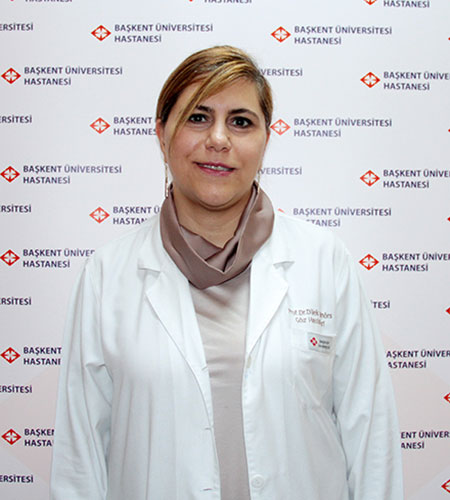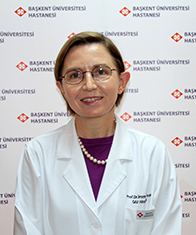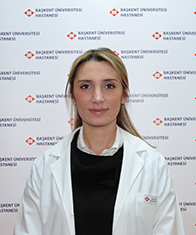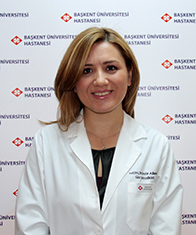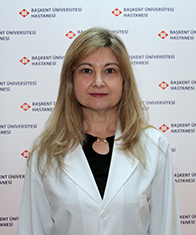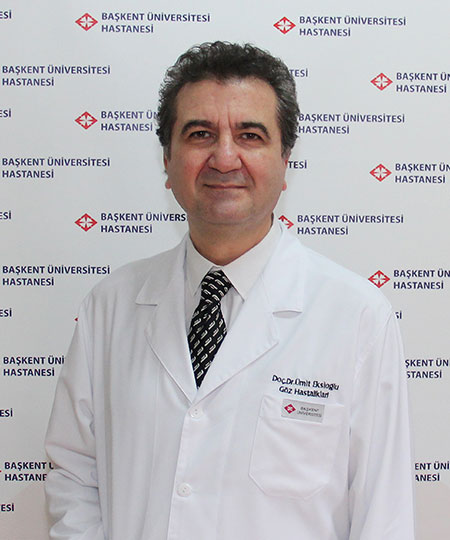Ophthalmology
The Ophthalmology department includes cornea-contact lens and refractive surgery, uvea, glaucoma, medical retina and vitro-retinal surgery, pediatric ophthalmology, strabismus, oculoplastic surgery and low vision aid units. These units provide services with advanced experience and technology.
Retina
Our retina unit, which is fully equipped, is one of the reference retina units in Turkey. In the retina unit fundus fluorescein angiography (FFA), argon laser photocoagulation, optical coherence tomography (OCT), photodynamic treatment (PDT), intravitreal injections as well as vitreo-retinal surgeries are performed for the diagnosis and treatment of retinal diseases. Diagnosis, treatment and follow up of retinopathy of prematurity (ROP), retinal tears, retinal hemorrhage, retinal detachments, diabetic retinopathy (DRP), age related macular degeneration (AMD), central serous retinopathy and other retinal diseases are all successfully performed.
Emergency treatment may be needed in cases of floaters or light flashes in the eye, or sudden visual losses. In such situations or in case of a sudden change in the actual state of a retinal disorder, you have to obtain an urgent appointment from our hospital. You will receive services immediately upon your admission, and an early intervention will be possible.
Cornea and External Diseases
Diseases of the cornea and external eye, including dystrophies, infections, corneal swelling, dry eyes, pterygium and external eye injuries are evaluated and treated by an expert team. Treatments for these conditions may include topical medications, oral medications or surgical interventions such as ocular surface reconstruction, limbal stem cell transplantation, sutureless pterygium surgery or amniotic membrane transplantation.
Corneal transplantation surgeries are performed routinely at the department. Penetrating keratoplasty (PK), and lamellar keratoplasty techniques including deep anterior lamellar keratoplasty (DALK) and Descemet membrane endothelial keratoplasty (DMEK) are performed by an experienced surgical team.
Refractive surgery is performed to treat nearsightedness, astigmatism and farsightedness. LASIK (laser-assisted in situ keratomileusis), PRK (photorefractive keratectomy) and phakic intraocular lenses (implantable contact lenses) are options to treat these refractive errors. Each patient is evaluated carefully before choosing the appropriate treatment option. Laser-assisted in situ keratomileusis is performed with the FDA approved WaveLight® Allegretto Wave® Eye-Q excimer laser which tracks the unique shape of your eye and allows individualized laser vision correction treatment with exceptional precision and safety.
Contact Lens
Contact lens fitting is performed for correction of refractive errors including myopia, hypermetropia, astigmatism and presbyopia. Keratoconus patients are fitted with soft, hybrid, rigid gas permeable or higher diameter scleral lenses. Each patient is evaluated carefully, and trial lenses are used for determination of the most suitable contact lens. Using scleral contact lenses, many patients may avoid or postpone corneal transplantation surgery. Corneal collagen crosslinking is performed for keratoconus patients to stop the progression of the disease. Ultraviolet A light and eye drops containing riboflavin are used in this treatment to stimulate collagen cross-linking in the corneal stroma, hence increasing the biomechanical stability of the cornea. A refractive surgical procedure, photorefractive keratectomy, can be combined with this procedure which also helps to decrease the refractive error and increase visual acuity in keratoconus patients.
High quality national and international clinical and laboratory research is also carried out by the faculty staff and research assistants in the cornea and anterior segment unit of the Ophthalmology Department.
Uveitis
Uvea is the vascular middle coat of the eye, consisting of iris, choroid and ciliary processes. Uveitis is the inflammation of this layer, associated with autoimmune or infectious diseases. Uveitis warning signs often start suddenly and get worse quickly. The symptoms are eye redness, pain and blurred vision. Presentation can be unilateral or bilateral. Uveitis is commonly seen in patients between the ages of 20-50, but it may also affect children. Ocular involvement can be serious, leading to permanent vision loss. Early diagnosis and treatment are important to prevent the complications. The aim of treatment is primarily to eliminate inflammation, alleviate pain, prevent further tissue damage, and restore any loss of vision. Treatment strategies vary depending on the type of uveitis. Medical management with steroids and immunosuppressants, biological agents, surgical management of secondary cataract due to uveitis, management of secondary glaucoma is performed in this unit. This unit is run by close coordination with other specialties such as rheumatology, infectious disease specialists, and pediatrics.
Glaucoma
Glaucoma is a term describing a group of ocular disorders with multi-factorial etiology united by a clinically characteristic intraocular pressure-associated optic neuropathy. It is crucial to diagnose glaucoma at early stages as it can permanently damage vision in the affected eye(s) and lead to blindness if left untreated. Glaucoma does not produce any symptoms until the individual losses their vision, which is irreversible, although its advance can be prevented if detected early. The methods and instruments that are used to diagnose and treat glaucoma include tonometers that measure the intra-ocular pressure, pachymetry that measures the thickness of the cornea, visual field test (Humphrey) which demonstrates the extent of visual loss in the optic nerve and optic nerve fiber analysis (HRT, OCT), which is the product of modern technology. We treat more than 5,000 patients a year with the latest technology in optic nerve imaging and visual fields. We have special expertise in laser treatments and surgical techniques, including the use of glaucoma drainage devices such as the Ahmed Glaucoma Valve. Our ophthalmologists have expertise in all types of glaucoma: congenital, combined mechanism, narrow-angle, open-angle and normal tension.
Oculoplastic Surgery
In the oculoplastic surgery unit, blepharoplasty for upper eyelid dermatochalasis, eyelid malposition correction including ectropion (eversion of the eyelid) and entropion (inversion of the eyelid) surgeries, and surgical and medical treatment of nasolacrimal system obstruction in children and adults, are performed. Medical treatment of blepharospasm (involuntary contraction of the muscles of the eyelids) by botulinum toxin injection is also performed in our clinic. In patients with malposition and inward growing of eyelashes (trichyasis) irritation and scarring of the eyes may occur. These trichiatic eyelashes can be permanently epilated by electrolysis. All oculoplastic interventions are performed with special care for the ocular surface health.
Ocular manifestations of thyroid disease and facial nerve paralysis are diagnosed and treated with close interaction of the related disciplines including the Endocrinology and Otorhinolaryngology Departments. Periocular and orbital infectious and inflammatory diseases are also diagnosed and treated in our Department. Rapid multidisciplinary evaluation is possible when needed, due to the fast and professional consultations with the related specialties.
Low Vision Aid
The low vision aid unit serves patients who have impaired vision due to different eye diseases which cannot be corrected by glasses, surgery or medication. The most common cause of low vision are age-related macular degeneration and diabetes. Other common causes include late stage glaucoma and hereditary retinal diseases. In this department, the specialist can determine which lenses or low vision devices will help you to achieve the clearest possible image. These devices can help the patients with low vision to perform some daily tasks independently. More than one device may be needed for different tasks including watching TV, reading or using the computer. During evaluation in the low vision aid department, the specialist and patient work together to determine the best devices according to the needs of the patient and practice for the optimal use of each device.
Pediatric Ophthalmology and Strabismus
Pediatric ophthalmology and strabismus unit focuses on the full spectrum of pediatric eye problems and both childhood and adult strabismus (eye misalignment). From the moment the baby’s eyes first open, vision becomes one of the most powerful tools he or she has to learn about the world. Children’s eye problems range from routine examinations to the diagnosis and management of such problems as amblyopia (lazy eye), nasolacrimal duct obstruction (blocked tear ducts), cataracts, glaucoma, retinopathy of prematurity, and strabismus.
Strabismus is a vision problem in which both eyes do not look at the same point at the same time. There are six muscles that control the movement of each eye. The muscles in each eye must be coordinated and work together to produce normal, balanced, binocular vision. When both eyes are coordinated, the brain combines images from both eyes to create a single, 3D image. Strabismus can occur at any time -- infancy, early childhood or adulthood. In some adults it may be a worsening of a childhood misalignment and may result in double vision. Children are rarely afflicted with strabismus-related double vision because their brains are able to process the image from one eye while suppressing the vision in the other.
For children and adults, Başkent University Pediatric Ophthalmology and Strabismus Unit subscribe to the philosophy that every patient deserves the best possible care, bringing to bear the most modern of treatment modalities and instrumentation.
